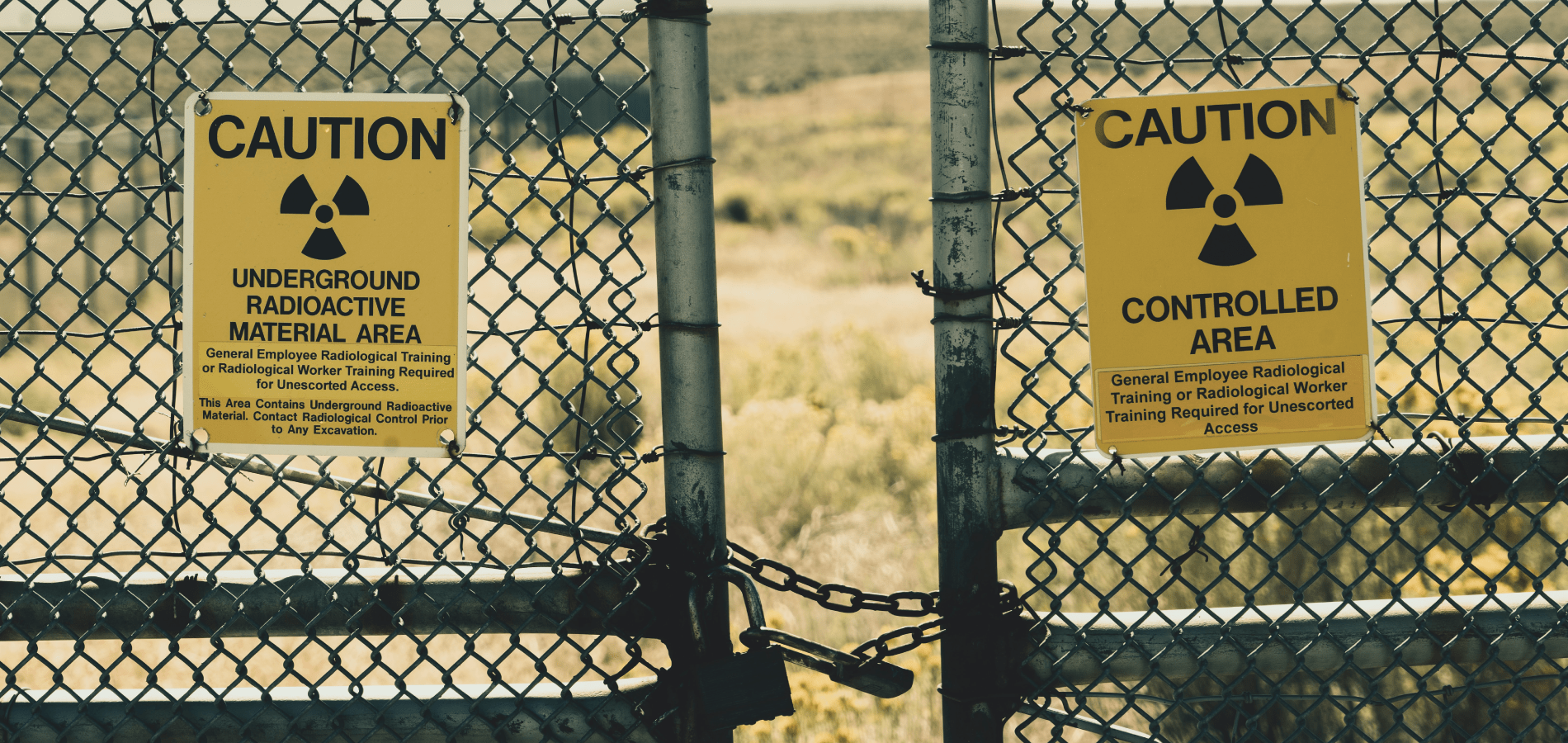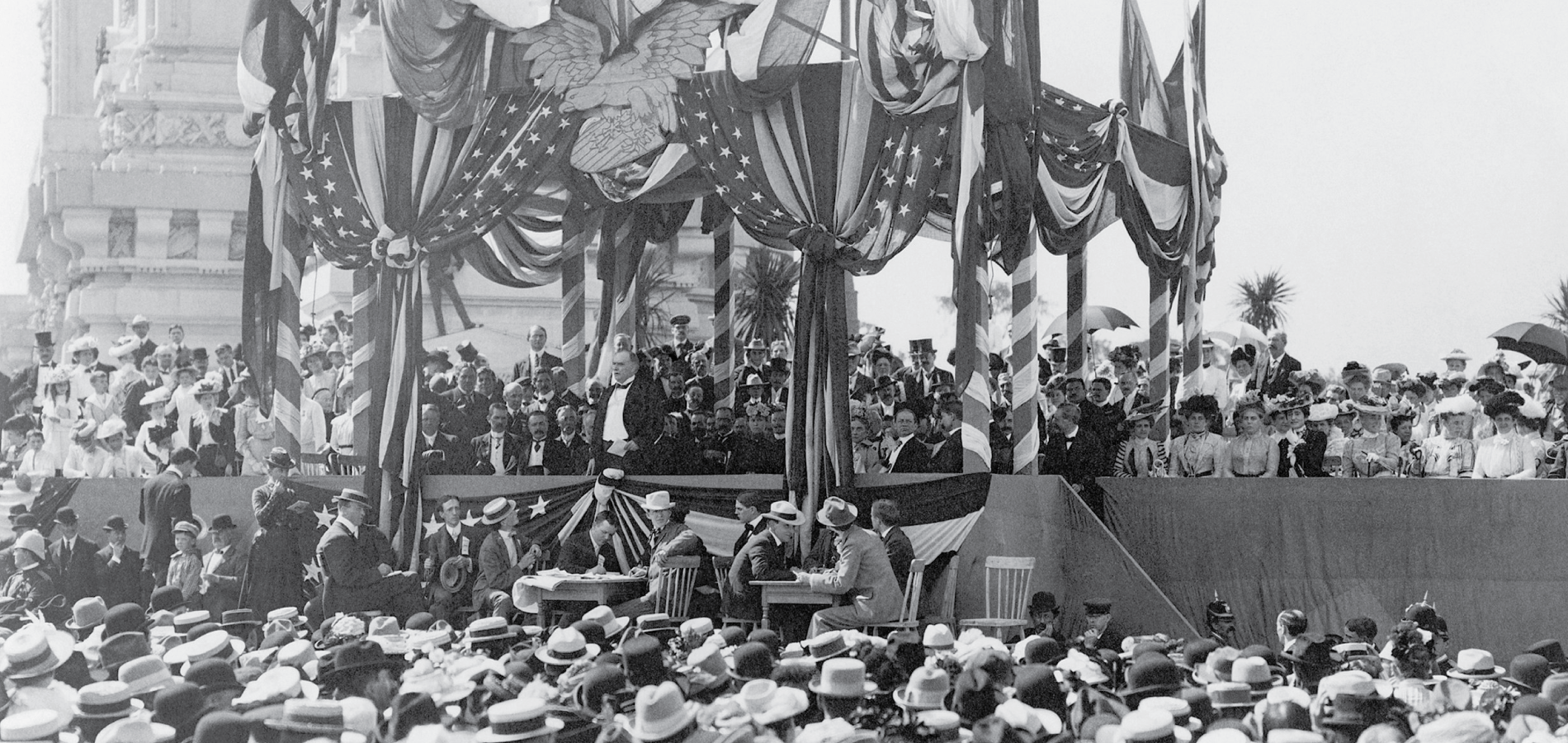On September 3, 1929, the Dow Jones Industrial Average was at an all-time high of 381.17. Americans were living large[1]“Farm relief possible without governmental paternalism ?.” U.S. Congressional Serial Set, , 1925, pp. I-8. HeinOnline, https://heinonline.org/HOL/P?h=hein.usccsset/usconset24537&i=964. This document can be found in … Continue reading—the war was over, cars were affordable, families were buying radios,[2]“Proceedings of Convention of American Instructors of the Deaf.” U.S. Congressional Serial Set, , 1929, pp. I-174. HeinOnline, https://heinonline.org/HOL/P?h=hein.usccsset/usconset24248&i=123. This document can be … Continue reading the sounds of jazz filled the clubs, and women were scandalizing older generations by revealing their ankles and cutting their hair. However, a little less than two months later, all of this would come to a screeching halt as a giant stock market crash left Wall Street and the American economy in shambles.
This month’s Secrets of the Serial Set post examines the lead-up and aftermath of the crash utilizing the valuable resources within HeinOnline’s U.S. Congressional Serial Set database.
The Roaring Economy of the 1920s
After the turmoil of World War I, America was ready to party—for nearly a decade. Americans in rural areas were moving to cities in droves to find jobs in the quickly growing industrial sector. Demand for goods was high. However, as a result, speculation was running wild;[3]“Message of the President to Congress, Dec. 3, 1929.” U.S. Congressional Serial Set, , 1929, pp. I-28. HeinOnline, https://heinonline.org/HOL/P?h=hein.usccsset/usconset24296&i=295. This document can be found in … Continue reading the stock market was booming, and regular Americans without much economic expertise found themselves investing, buying stocks largely with borrowed money.
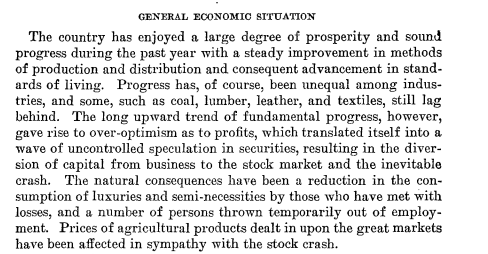
The warning signs were there—on March 25, 1929, the stock market faced a minor crash after the Federal Reserve warned financiers of excessive speculation,[4]“Factors affecting volume and stability of private investment.” U.S. Congressional Serial Set, , 1950, pp. I-236. HeinOnline, https://heinonline.org/HOL/P?h=hein.usccsset/usconset22660&i=31. This document can be found … Continue reading leading investors to quickly sell off their stocks. The crisis was averted when two days later, Charles E. Miller, owner of National City Bank, funneled $25 million in credit into stocks to bolster them back up.
But overproduction of steel and iron led to falling consumer demand[5]“Factors affecting volume and stability of private investment.” U.S. Congressional Serial Set, , 1950, pp. I-236. HeinOnline, https://heinonline.org/HOL/P?h=hein.usccsset/usconset22660&i=33. This document can be found … Continue reading and rising unemployment rates. Good harvesting seasons in America and other countries led to a global overproduction of crops[6]“Message of the President to Congress, Apr. 16, 1929.” U.S. Congressional Serial Set, , 1929, pp. I-6. HeinOnline, https://heinonline.org/HOL/P?h=hein.usccsset/usconset24241&i=8. This document can be found in … Continue reading as well, leading to dwindling prices that hurt the nation’s farmers. As a result, the U.S. began raising tariffs on international goods,[7]“Report of Tariff Commission, 1929.” U.S. Congressional Serial Set, , 1929, pp. I-292. HeinOnline, https://heinonline.org/HOL/P?h=hein.usccsset/usconset50977&i=33. This document can be found in HeinOnline’s U.S. … Continue reading and other nations followed suit, leading to a steady decline of international trade. Banks were loaning out money that they didn’t have, depleting customer savings to invest in the stock market in the hopes of getting big returns. Americans were going into debt taking out large amounts of credit to buy stocks[8]“25th annual report of Securities and Exchange Commission, 1959.” U.S. Congressional Serial Set, , 1960, pp. I-288. HeinOnline, https://heinonline.org/HOL/P?h=hein.usccsset/usconset37360&i=650. This document can be … Continue reading—by August 1929, over $8.5 billion was on loan,[9]“Planned economy for Wall Street, article by Charles H. Meyer.” U.S. Congressional Serial Set, , 1935, pp. I-10. HeinOnline, https://heinonline.org/HOL/P?h=hein.usccsset/usconset36412&i=1098. This document can be found … Continue reading more than the entire amount of currency in America at that point. Stock prices were much higher than their real value. However, stocks continued to grow through the beginning of September 1929, when they reached that impressive 381.17 peak.[10]“Planned economy for Wall Street, article by Charles H. Meyer.” U.S. Congressional Serial Set, , 1935, pp. I-10. HeinOnline, https://heinonline.org/HOL/P?h=hein.usccsset/usconset36412&i=1094. This document can be found … Continue reading Even economist Irving Fisher stated, “Stock prices have reached what looks like a permanently high plateau.”[11]“Economic Report of the President, February 2000.” U.S. Congressional Serial Set, , 2000, pp. [i]-432. HeinOnline, https://heinonline.org/HOL/P?h=hein.usccsset/usconset21894&i=103. This document can be found in … Continue reading
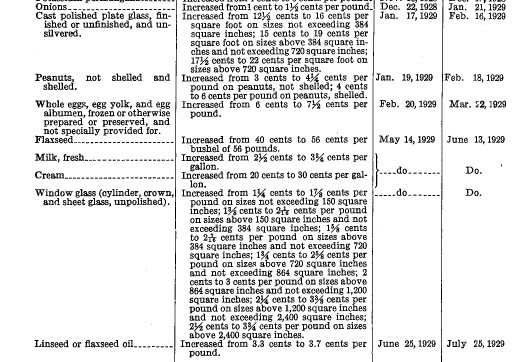
Not everyone was so optimistic. On September 8, financial expert Roger Babson predicted, “a crash is coming, and it may be terrific.” Just a few weeks later, the London Stock Exchange crashed after a top British investor was arrested for fraud and forgery.[12]Brooks, Collin, Editor. Royal Mail Case. Notable British trials series. Edinburgh and London, W. Hodge & Company, limited. HeinOnline, https://heinonline.org/HOL/P?h=hein.trials/royal0001&i=44. This document can be found … Continue reading Investors in the U.S. began to get nervous, leading to a few weeks of market instability. At the beginning of October, Philip Snowden, Chancellor of the Exchequer in Great Britain, referred to America’s stock market as “a perfect orgy of speculation,” which would find itself collapsing just a few weeks later.
The Crash
Stock prices started to fall in early October as increasing numbers of investors sold their stocks, leading to three crucial events.
Black Thursday
On October 24, 1929,[13]“The Senate, 1789-1989, addresses on history of U.S. Senate.” Congressional Serial Set, , 1987, pp. i-800. HeinOnline, https://heinonline.org/HOL/P?h=hein.usccsset/usconset51397&i=474. This document can be found in … Continue reading the stock market lost 11% of its value when investors sold 12,894,650 shares. The stock tickers couldn’t keep up with all of the selling, which meant that price reports were sent late, leading to immense confusion along Wall Street. To combat the chaos, lead financiers from Morgan Bank, Chase National Bank, and National City Bank of New York met together and selected Richard Whitney, VP of the New York Exchange, to purchase 25,000 shares of US Steel at $205 per share—far above market price. He also put high bids on several other stocks. This helped the market to recover, and by the end of the day, the Dow was only down by 6.38 points.
Black Monday
The following Monday, October 28, investors were leaving the market in droves. There was a record loss of 38.33 Dow points that day, dropping nearly 13% in one day.
Black Tuesday
On October 29, investors traded a whopping 16,410,030 shares on the New York Stock Exchange. Billions of dollars were lost, while thousands of investors were wiped out.[14]“Agriculture, Rural Development and related agencies appropriation bill, 1979.” U.S. Congressional Serial Set, , 1978, pp. 1-124. HeinOnline, https://heinonline.org/HOL/P?h=hein.usccsset/usconset21097&i=247. This … Continue reading Some stocks lost all of their buyers. Tickers were running hours late trying to keep up with the chaos, and by the end of the day the Dow lost an additional 30.57 points.
Again, prominent financiers attempted to buy large quantities of stocks to stabilize the market, but this time it didn’t work.
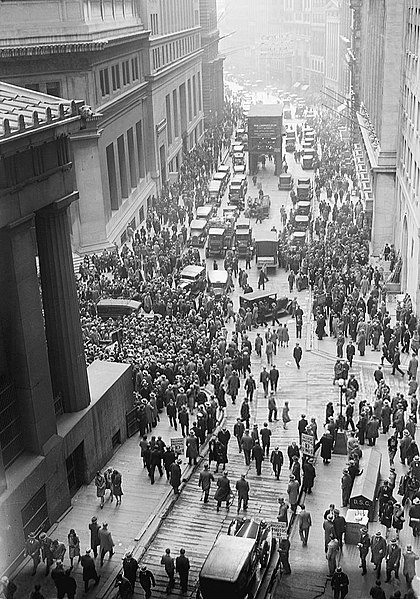
The Aftermath
The Dow recovered slightly on October 30, regaining 28.40 points, but it continued to fall, reaching nearly half of its September peak by November 13. After a few months of meager recovery, the stock market made a steady decline from April 1930 until July 1932, reaching its lowest point of the century, 41.22, on July 8 of that year,[15]“Planned economy for Wall Street, article by Charles H. Meyer.” U.S. Congressional Serial Set, , 1935, pp. I-10. HeinOnline, https://heinonline.org/HOL/P?h=hein.usccsset/usconset36412&i=1097. This document can be found … Continue reading marking an 89.2% index loss in less than three years. In fact, the stock market wouldn’t return to pre-crash levels until November 1954.

While the crash was a factor of the Great Depression, it is important to note that it was not the sole cause.[16]“Factors affecting volume and stability of private investment.” U.S. Congressional Serial Set, , 1950, pp. I-236. HeinOnline, https://heinonline.org/HOL/P?h=hein.usccsset/usconset22660&i=35. This document can be found … Continue reading But regardless, countless Americans lost their jobs and their life savings. Businesses went bankrupt. Families went hungry.[17]“Price support programs for basic commodities, wheat, and dairy products. 2 pts.” U.S. Congressional Serial Set, , 1955, pp. 1-8. HeinOnline, https://heinonline.org/HOL/P?h=hein.usccsset/usconset22491&i=768. This … Continue reading The economy wouldn’t recover until World War II stimulated the industrial sector. To help prevent such a crash from occurring again, President Franklin D. Roosevelt would instate the Glass-Steagall Act,[18]“Financial Services Competitive Equity Act.” U.S. Congressional Serial Set, , 1984, pp. 1-116. HeinOnline, https://heinonline.org/HOL/P?h=hein.usccsset/usconset20486&i=998. This document can be found in … Continue reading which drew a separation between commercial and investment banks, as well as the Federal Deposit Insurance Corporation (FDIC),[19]“Report of General Accounting Office, 1937.” U.S. Congressional Serial Set, , 1937, pp. I-160. HeinOnline, https://heinonline.org/HOL/P?h=hein.usccsset/usconset34414&i=499. This document can be found in … Continue reading which insured bank deposits. In addition, the Securities Act of 1933[20]“25th annual report of Securities and Exchange Commission, 1959.” U.S. Congressional Serial Set, , 1960, pp. I-288. HeinOnline, https://heinonline.org/HOL/P?h=hein.usccsset/usconset37360&i=653. This document can be … Continue reading provided for federal regulation of the sale and purchase of securities to protect the stock market.
Help Us Complete the Project
Secrets of the Serial Set is an exciting and informative blog series from HeinOnline dedicated to unveiling the wealth of American history found in the United States Congressional Serial Set. Documents from additional HeinOnline databases have been incorporated to supplement research materials for non-U.S. related events discussed.
These posts have been so informative; they enable both patrons and staff to understand what the Serial Set is and how invaluable it is to all kinds of research.
The U.S. Congressional Serial Set is considered an essential publication for studying American history. Spanning more than two centuries with more than 17,000 bound volumes, the records in this series include House and Senate documents, House and Senate reports, and much more. The Serial Set began publication in 1817 with the 15th Congress, 1st session. U.S. congressional documents prior to 1817 are published as the American State Papers.
The Serial Set is an ongoing project in HeinOnline, with the goal of adding approximately four million pages each year until the archive is completed. To date, we’ve completed 95% of the project! View the current status of HeinOnline’s Serial Set project below.
If your library holds all or part of the Serial Set, and you are willing to assist us, please contact Shannon Hein at 716-882-2600 or shein@wshein.com. HeinOnline would like to give special thanks to the following libraries for their generous contributions which have resulted in the steady growth of HeinOnline’s U.S. Congressional Serial Set.
- Buffalo & Erie County Public Library
- University at Buffalo
- Villanova Law Library
- Wayne State University
- University of Utah
- UC Hastings
- University of Montana
- Law Library of Louisiana
- George Washington University
- University of Delaware
- Southern Illinois University, Morris Library
- University of Wisconsin Oshkosh
We will continue to need help from the library community to complete this project. For a complete list of remaining missing volumes of the Serial Set, please email our Marketing Team at marketing@wshein.com.
HeinOnline Sources[+]
| ↑1 | “Farm relief possible without governmental paternalism ?.” U.S. Congressional Serial Set, , 1925, pp. I-8. HeinOnline, https://heinonline.org/HOL/P?h=hein.usccsset/usconset24537&i=964. This document can be found in HeinOnline’s U.S. Congressional Serial Set database. |
|---|---|
| ↑2 | “Proceedings of Convention of American Instructors of the Deaf.” U.S. Congressional Serial Set, , 1929, pp. I-174. HeinOnline, https://heinonline.org/HOL/P?h=hein.usccsset/usconset24248&i=123. This document can be found in HeinOnline’s U.S. Congressional Serial Set database. |
| ↑3 | “Message of the President to Congress, Dec. 3, 1929.” U.S. Congressional Serial Set, , 1929, pp. I-28. HeinOnline, https://heinonline.org/HOL/P?h=hein.usccsset/usconset24296&i=295. This document can be found in HeinOnline’s U.S. Congressional Serial Set database. |
| ↑4 | “Factors affecting volume and stability of private investment.” U.S. Congressional Serial Set, , 1950, pp. I-236. HeinOnline, https://heinonline.org/HOL/P?h=hein.usccsset/usconset22660&i=31. This document can be found in HeinOnline’s U.S. Congressional Serial Set database. |
| ↑5 | “Factors affecting volume and stability of private investment.” U.S. Congressional Serial Set, , 1950, pp. I-236. HeinOnline, https://heinonline.org/HOL/P?h=hein.usccsset/usconset22660&i=33. This document can be found in HeinOnline’s U.S. Congressional Serial Set database. |
| ↑6 | “Message of the President to Congress, Apr. 16, 1929.” U.S. Congressional Serial Set, , 1929, pp. I-6. HeinOnline, https://heinonline.org/HOL/P?h=hein.usccsset/usconset24241&i=8. This document can be found in HeinOnline’s U.S. Congressional Serial Set database. |
| ↑7 | “Report of Tariff Commission, 1929.” U.S. Congressional Serial Set, , 1929, pp. I-292. HeinOnline, https://heinonline.org/HOL/P?h=hein.usccsset/usconset50977&i=33. This document can be found in HeinOnline’s U.S. Congressional Serial Set database. |
| ↑8 | “25th annual report of Securities and Exchange Commission, 1959.” U.S. Congressional Serial Set, , 1960, pp. I-288. HeinOnline, https://heinonline.org/HOL/P?h=hein.usccsset/usconset37360&i=650. This document can be found in HeinOnline’s U.S. Congressional Serial Set database. |
| ↑9 | “Planned economy for Wall Street, article by Charles H. Meyer.” U.S. Congressional Serial Set, , 1935, pp. I-10. HeinOnline, https://heinonline.org/HOL/P?h=hein.usccsset/usconset36412&i=1098. This document can be found in HeinOnline’s U.S. Congressional Serial Set database. |
| ↑10 | “Planned economy for Wall Street, article by Charles H. Meyer.” U.S. Congressional Serial Set, , 1935, pp. I-10. HeinOnline, https://heinonline.org/HOL/P?h=hein.usccsset/usconset36412&i=1094. This document can be found in HeinOnline’s U.S. Congressional Serial Set database. |
| ↑11 | “Economic Report of the President, February 2000.” U.S. Congressional Serial Set, , 2000, pp. [i]-432. HeinOnline, https://heinonline.org/HOL/P?h=hein.usccsset/usconset21894&i=103. This document can be found in HeinOnline’s U.S. Congressional Serial Set database. |
| ↑12 | Brooks, Collin, Editor. Royal Mail Case. Notable British trials series. Edinburgh and London, W. Hodge & Company, limited. HeinOnline, https://heinonline.org/HOL/P?h=hein.trials/royal0001&i=44. This document can be found in HeinOnline’s World Trials Library. |
| ↑13 | “The Senate, 1789-1989, addresses on history of U.S. Senate.” Congressional Serial Set, , 1987, pp. i-800. HeinOnline, https://heinonline.org/HOL/P?h=hein.usccsset/usconset51397&i=474. This document can be found in HeinOnline’s U.S. Congressional Serial Set database. |
| ↑14 | “Agriculture, Rural Development and related agencies appropriation bill, 1979.” U.S. Congressional Serial Set, , 1978, pp. 1-124. HeinOnline, https://heinonline.org/HOL/P?h=hein.usccsset/usconset21097&i=247. This document can be found in HeinOnline’s U.S. Congressional Serial Set database. |
| ↑15 | “Planned economy for Wall Street, article by Charles H. Meyer.” U.S. Congressional Serial Set, , 1935, pp. I-10. HeinOnline, https://heinonline.org/HOL/P?h=hein.usccsset/usconset36412&i=1097. This document can be found in HeinOnline’s U.S. Congressional Serial Set database. |
| ↑16 | “Factors affecting volume and stability of private investment.” U.S. Congressional Serial Set, , 1950, pp. I-236. HeinOnline, https://heinonline.org/HOL/P?h=hein.usccsset/usconset22660&i=35. This document can be found in HeinOnline’s U.S. Congressional Serial Set database. |
| ↑17 | “Price support programs for basic commodities, wheat, and dairy products. 2 pts.” U.S. Congressional Serial Set, , 1955, pp. 1-8. HeinOnline, https://heinonline.org/HOL/P?h=hein.usccsset/usconset22491&i=768. This document can be found in HeinOnline’s U.S. Congressional Serial Set database. |
| ↑18 | “Financial Services Competitive Equity Act.” U.S. Congressional Serial Set, , 1984, pp. 1-116. HeinOnline, https://heinonline.org/HOL/P?h=hein.usccsset/usconset20486&i=998. This document can be found in HeinOnline’s U.S. Congressional Serial Set database. |
| ↑19 | “Report of General Accounting Office, 1937.” U.S. Congressional Serial Set, , 1937, pp. I-160. HeinOnline, https://heinonline.org/HOL/P?h=hein.usccsset/usconset34414&i=499. This document can be found in HeinOnline’s U.S. Congressional Serial Set database. |
| ↑20 | “25th annual report of Securities and Exchange Commission, 1959.” U.S. Congressional Serial Set, , 1960, pp. I-288. HeinOnline, https://heinonline.org/HOL/P?h=hein.usccsset/usconset37360&i=653. This document can be found in HeinOnline’s U.S. Congressional Serial Set database. |

